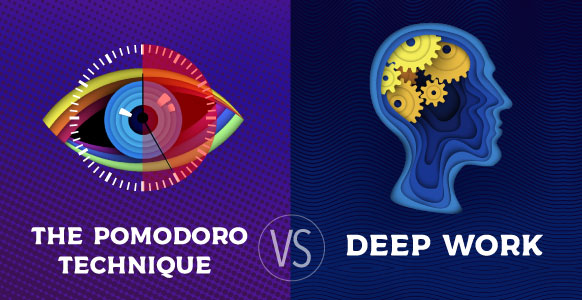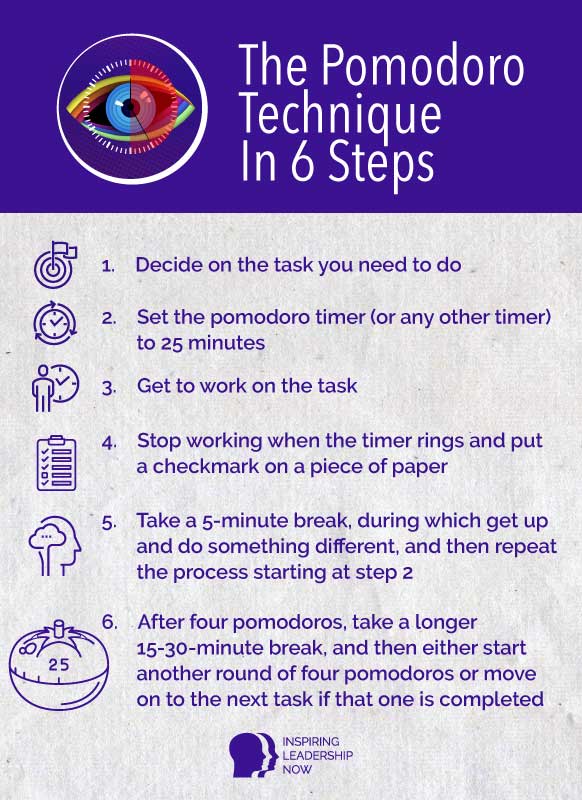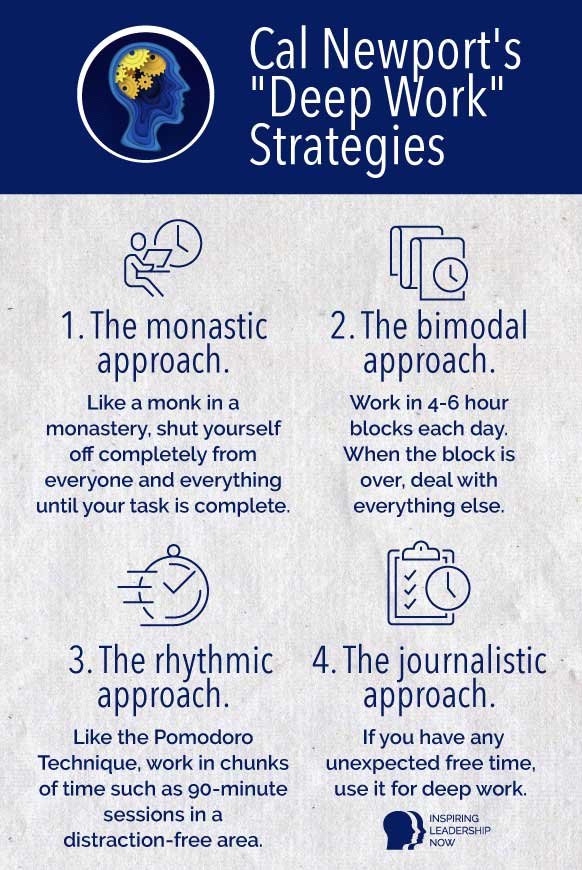Last updated: 15 August 2019

Looking for a fun way to charge up your leadership skills in just a few minutes a day? Get your FREE Inspiring Leadership Cards Quote Deck for 49 powerful leadership quotes from history’s greatest leaders and practical action steps you can apply to your career right now. But hurry! Supplies are LIMITED so don’t miss out – grab yours now! (Just cover S+H)
In this article, we’re going to look at how the popular Pomodoro Technique fares with Deep Work in terms of maximizing your productivity.
We’ll take a look at which of these time management tools is right for your working needs – because as with most things in life, it’s not a case of one size fits all.
But first up, why has “working smarter” become such an obsession, especially in the online world?
Well, hate to disappoint, it’s nothing you probably don’t already know – but it’s largely down to the fact that nowadays there are so many distractions vying for your time.
The technological revolution plays an enormous part in this, which obviously has created infinite possibilities and made it possible for anyone to become an entrepreneur.
But entrepreneur or not – the influx of digital communication you receive on a daily basis literally can be endless – meaning it’s becoming increasingly difficult to not only switch off, but to stay focused and get sh*t done!
Given this, working smarter and productivity has become increasingly important, even more so if you work from home or remotely, where the freedom introduces a world full of other distractions.
Staying focused on a task can be a real challenge, which is why we thought we’d look at two popular time management techniques to see how they measure up when it comes to staying focused and improving your productivity:
1. The Pomodoro Technique
2. Deep Work
What Is The Pomodoro Technique? (And Does It Involve Tomatoes?)
So despite the name (Pomodoro means tomato in Italian), there were no tomatoes harmed in the making of this technique!
The Pomodoro Technique was developed by Francesco Cirillo in the late 1980s using a tomato-shaped kitchen timer (called a pomodoro) that Cirillo used himself when he was a student.
The idea behind the timer is to break your work down into more manageable chunks, each piece followed by a short break.
Each “pomodoro” lasts for 25 minutes, followed by a break of 5 minutes. So you work diligently for 25 minutes without any distractions, and then you take a 5-minute breather.
The original technique has 6 steps, these are:

There’s nothing spectacular or revolutionary about the technique, but the simplicity behind it is key to its success. As you can see, it chops your work time up into manageable chunks.
For instance, the whole technique includes 4 x 25-minute sessions of work, plus 3 x 5-minute breaks, and 1 x 30-minute break at the end. If you add them all up it comes to 145 minutes, or 2 hours and 25 minutes.
So the whole point of the technique is so you work in concentrated and powerful spurts so you can then take adequate breaks to refresh your mind and body.
This is advantageous because:
1. It’s easier to focus for shorter bursts of time
2. Taking breaks prevents burnout and fatigue
The Pomodoro Technique helps you manage your time more effectively by giving you a short-term goal to achieve, i.e. work straight through for just 25 minutes.
After that, you get a reward (your 5-minute break) during which time you’re able to unwind and quickly refresh yourself before getting back to work.
Managing your time more efficiently means that you get more work done. You don’t sit around twiddling your thumbs because you’re always working toward that short-term goal of 25 minutes.
When the timer rings, put your checkmark on paper, and you feel like you’ve accomplished something, which gives you the motivation to work through each subsequent pomodoro. Keep on doing this and you’re bound to increase your productivity, simply because none of your work time is being wasted.
There are some tasks that are particularly well suited to The Pomodoro Technique, which will be highlighted a little later in the article.
Other tasks, however, need a more in-depth approach so that you can focus on them for longer periods of time without being interrupted or distracted…
Which leads us to our next technique…
What Is Deep Work?
Deep Work is a technique developed by Cal Newport in his book Deep Work: Rules for Focused Success in a Distracted World.
The idea behind it is to be able to block out all distractions so that you can devote all your energy to one main task or project.
According to Newport, there are two types of work:
1. Shallow work
2. Deep work
Shallow work is work that practically anyone can do. It might involve answering the telephone, replying to emails, filing, and so on. It usually requires just a bit of time and very little focus. It’s work that keeps you busy, but that doesn’t result in anything of value or consequence.
This is not to say shallow work can’t be important. For instance, catching up on admin is important, but it just might not be your overall priority.
To ensure you don’t drop the ball on either, Newport recommends scheduling every minute of your day – including meals and breaks.
That way you can allot time for shallow work activities, which you would schedule after your deep work session.
Deep work is all about creating value and enhancing your skills.
A typical example would be the author who locks himself or herself away in a cottage in the woods, turns off the phone and TV, and does nothing but write until their next blockbuster is finished.
So if you can master your focus (i.e. avoid being distracted) then you will be able to achieve a higher quality output in less time.
But how do you master your focus and prevent distractions from creeping in? Newport recommends the following:
- Use one of the 4 deep work strategies (which we’ll take a look at below)
- Practice productive meditation
- Finish work at the same time each day
So let’s take a look at each of these below. First up, the 4 deep work strategies:

For most people, the monastic approach might be tricky to pull off. Not everyone will have the luxury of being able to disappear to a woodland retreat for weeks on end.
Likewise, if you thought the rhythmic approach might suit you, then you might as well use the Pomodoro Technique.
And the journalistic approach revolves around fitting deep work into a busy schedule, which is only recommended for people who are experienced at deep work (or need to get good at it… fast!)
So what’s productive meditation all about?
It refers to devoting any unproductive time to deep thinking.
This includes what you might call non-work activities, such as shopping, commuting, taking a shower, jogging, doing household chores, walking the dog, and so on.
Whenever you’re doing these things, use the time to try to solve a complex problem. When you’re away from work your brain is free to relax and make connections, which it’s able to do when you’re engaged in activities that don’t require any deep thinking.
Finally, Newport suggests finishing work at the same time each day. That might seem like a simple suggestion, but it’s also a powerful tool. It gives you permission to stop, at 5.30 pm, for example. After that, no emails, no phone calls, no meetings, and nothing whatsoever to do with work.
This is particularly important for remote workers or entrepreneurs who might have erratic working hours or who are simply unable to switch off.
What Makes Deep Work & The Pomodoro Techniques So Effective?

Deep work is all about creating the right environment to work in, shutting yourself off from distractions so you can focus for as long as is necessary.
If you can’t take yourself off to a cabin in the woods, then you need to do the next best thing.
That might be making sure you aren’t disturbed for 5 hours. It might also mean shutting off your phone and disabling your internet access.
Once people know about the way you work, they’ll eventually respect it and stop bothering you during your “deep work” hours.
You can also choose a time slot each day when you deal with emails and phone calls, making it only as long as it absolutely needs to be. Likewise, you’d want to avoid the temptation of social media until all your work was finished for the day.
You could say that deep work is a bit like throwing yourself into your work. What it gives you is the absolute freedom to work on the one thing that needs to be done without any distractions or interruptions. And that will ultimately decrease the amount of time you need to complete it.
With the Pomodoro Technique, the emphasis is on boosting your productivity. By working in small chunks, you optimize your brainpower, and by taking breaks you stop before that brainpower gets drained.
It’s effective because breaking things up like this keeps you fresh and alert. And because each pomodoro is only 25 minutes, it doesn’t feel like you’re working quite so hard, even though a complete cycle lasts nearly two and a half hours.
But what about distractions? They can still get at you. To avoid them, some people work through their pomodoros (25-minute sections) while listening to music through headphones. That way they aren’t disturbed by office noise, conversations, telephones, or any sounds from outside.
That gives you a good idea of what the two techniques are and how they work. But is one more suitable for a particular task than the other?
The Pomodoro Technique vs. Deep Work: Which Technique Is Right For Your Working Needs?

The Pomodoro Technique is ideal for anybody who needs to produce batches of creative work on a regular basis, such as writing a set amount of words in a given time, sketching out the first part of a storyboard, drafting the chapter titles for a book, and so on.
It could benefit designers, developers, script writers, or other professionals working toward deadlines or submitting work to be critiqued by others.
The technique works for just about anyone and any task. You could use it just to clear your inbox, stopping when the timer goes off. Or if you’re into DIY or crafts, you can work intently for 25 minutes, and then when the timer goes off take the opportunity to step back and evaluate what you’ve done, where you’re at, and what you should do in the next pomodoro.
Deep work is also perfect for creative pursuits, but perhaps better suited to those that require more in-depth work over longer periods of time. It’s been described as the ability to focus without distraction on a cognitively demanding task
Going deep is often a necessary part of being a writer, a composer, or a programmer, for instance. That makes sense, because writing a play or a novel is difficult. The same goes for writing a symphony or a hit song. Or creating some programming that takes technology to the next level.
Tasks like these are what you’d call cognitively demanding. They require total focus, plenty of time and the ability to devote yourself completely to what you’re doing in a distraction-free environment.
You could argue that it’s possible to use either technique for any task and in any profession. With the Pomodoro Technique you can work for as long as you want to, but you get regular breaks to help you stay alert and prevent burnout. You also get to put those checkmarks on paper so that you can see the progress you’re making in black and white.
Deep work doesn’t rely on time management in the same way. You’d use this technique when you had the option to lock yourself away from the rest of the world and when you wanted to get to grips with a particularly complex task that needed total focus and commitment.
Also, it’s perfectly possible that you might use each of the techniques at different times. It’s not necessarily a question of one or the other, unless you find one system easier to cope with than the other.
One important thing to keep in mind is this: these two techniques are not set in stone. You can adapt them to suit yourself and the way you work. If five hours of deep work is too much, try starting with one hour and build up from there.
Likewise, if the Pomodoro Technique’s 25-5 ratio doesn’t work for you, create one that does. Maybe you’d prefer working for 20 minutes and taking a 10-minute break. The technique is just a model, and you can adapt it to suit yourself. Choose the work and break times that you’re happy with and that bring you results.
Is There Any Scientific Data To Support These Two Time Management Tools?
Any technique that helps you work smarter and avoid distractions is a bonus. But it would be even better if their alleged benefits had some basis in science, wouldn’t it?
As it turns out, they do. Here are just a few of the things that happen in your brain when you put these techniques into practice.
Starting with the Pomodoro Technique, why is taking a break so important?
According to a study by Atsunori Ariga and Alejandro Lleras reported in the journal Cognition, your brain is designed to respond to change, so sticking to a single task for too long can actually hamper your performance.
But there’s also more to it than that. For example, research has shown that when there are shorter periods between rewards, your brain is more motivated to complete the task and claim the reward. In the Pomodoro Technique, the reward is the break.
Then there’s the issue of time. If you’re rushing against the clock to get tasks done or rushing to get to a meeting and worried you’re going to be late, then time can seriously stress you out.
But when you use the Pomodoro Technique, time becomes your friend, helping you reach your goal rather than being something you have to battle against.
The Pomodoro Technique has also been praised as being an effective way to fight procrastination. It can be a particularly useful way to get any boring tasks done that you’ve been putting off, like tax returns, thank-you notes, and the like. Just set the timer for 25 minutes and get the job done.
There isn’t as much statistical information to support the Deep Work technique. However, the point about practicing productive meditation should be noted. It’s a well-known fact that when you’re trying to solve a complex problem and you stop and go and do something completely different, the answer often seems to just pop into your head. That’s because your brain has the time and space to sift through all the information, absorb it, and come up with a solution.
In summary, Deep Work is about creating a distraction-free environment where you are free to focus intently on the task at hand. This kind of environment helps you concentrate on what you want to do so that you can get into the flow. The Pomodoro Technique can be used with deep work or shallow work, as a way to get yourself going, or as a method for beating procrastination.
You can use one or both techniques depending on the type and length of task you need to do. However you decide to use them, they’re guaranteed to help you get more work done of a higher quality, and reduce feelings of overwhelm.
>>Interested in discovering more fun ways to improve the way you work, think and inspire others? We have a special treat for you:
… The FREE Inspiring Leadership Cards Quote Deck!
Containing the words and wisdom of history’s greatest leaders – these limited edition cards are like having the all-time most influential leaders by your side each day, encouraging you to become a better leader!
Claim Your FREE cards now to receive:
- 49 powerful Leadership Quotes from the world’s greatest leaders, including Steve Jobs, Albert Einstein, Martin Luther King Jr., Oprah Winfrey, Abraham Lincoln and many more so you can harness the wisdom that shaped history
- 49 winning Leadership Qualities that’ll transform you into the kind of leader others respect and feel inspired to follow
- 49 practical Action Steps you can refer to on a daily basis to enhance your innate ability to inspire – just watch how others naturally gravitate towards you!
But hurry, supplies are limited so don’t miss out – grab your Inspiring Leadership Cards now!


